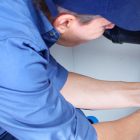Washing machine hoses are essential parts of your laundry system, yet many homeowners overlook their maintenance until it’s too late. Worn-out or old hoses can lead to leaks, water damage, and expensive repairs. Replacing washing machine hoses before they fail is a smart move, saving you from potential headaches.
In this guide, we’ll show you how to replace washing machine hoses step-by-step, and we’ll also explain why it’s important, how often you should do it, and tips for ensuring a smooth replacement process. Let’s dive in!
Contents
Why Should You Replace Washing Machine Hoses?
Washing machine hoses are constantly under pressure, carrying water from your plumbing system to your washer. Over time, wear and tear can weaken these hoses, causing them to bulge, crack, or even burst. A damaged washing machine hose can flood your laundry room, damage floors, and even create mold problems.
Not only can replacing washing machine hoses help you avoid these problems, but it’s also a relatively simple DIY task. Manufacturers recommend replacing hoses every 3 to 5 years, even if they appear to be in good condition. However, if you notice any bulging, cracks, or leaks, it’s time to act immediately.
So, how do you know when it’s time to change your washing machine hoses? Here are some common signs:
- Visible cracks or wear on the hose’s surface
- Bulging or swelling
- Leaks at the connection points or along the hose
- Rust or corrosion around the fittings
Ignoring these signs can lead to costly damage, so it’s crucial to replace your washing machine hoses promptly. By following our guide, you’ll be able to handle this task with ease.
What You’ll Need to Replace Washing Machine Hoses
Before starting the replacement process, gather the tools and materials needed. Luckily, you won’t need much, and most items can be found at your local hardware store. Here’s a quick list of essentials:
- New washing machine hoses (choose stainless steel braided hoses for durability)
- Adjustable wrench
- Bucket or towel (to catch any leftover water)
- Plumber’s tape (optional but recommended)
Once you’ve gathered everything, you’re ready to start replacing your washing machine hoses. Make sure to choose hoses with sturdy fittings, as the quality of the connection points matters as much as the hoses themselves.
Step 1: Turn Off the Water Supply
The first step in replacing your washing machine hoses is to turn off the water supply to the washer. You’ll typically find the shut-off valves located behind the machine, where the hoses are connected to the wall. Turn both the hot and cold water valves clockwise to stop the flow of water.
Pro tip: Take this opportunity to inspect the valves and ensure they’re functioning properly. If they’re hard to turn or leaking, it may be worth replacing these valves at the same time.
After shutting off the water supply, you should also unplug the washing machine from the electrical outlet for safety. Even though this task doesn’t require working with electricity, it’s always a good idea to prevent any risk of accidents.
Step 2: Disconnect the Old Washing Machine Hoses
Now that the water is turned off and the machine is unplugged, it’s time to disconnect the old hoses. Place a bucket or towel underneath the connection points to catch any water that may spill out when you remove the hoses.
Using an adjustable wrench, carefully unscrew the fittings where the hoses connect to the back of the washing machine. Once you’ve disconnected the hoses from the machine, do the same at the wall connections.
Pro tip: Inspect the old washing machine hoses carefully for any signs of damage, as this will help you understand how they failed. If the hoses are difficult to remove, they may be corroded or rusted onto the fittings. A little extra elbow grease may be necessary, but be careful not to damage the connection points.
Step 3: Inspect and Clean the Connection Points
After removing the old washing machine hoses, take a moment to inspect and clean the connection points, both on the washing machine and the water supply valves. Look for any signs of rust, corrosion, or debris.
You can use a cloth to clean the connections, ensuring a smooth surface for your new hoses to attach. If you notice any corrosion, consider replacing the fittings to prevent future leaks. Keeping these parts clean and rust-free will help ensure your new hoses function effectively.
Also, now is a good time to use plumber’s tape on the threads of the fittings. Though it’s not always necessary, plumber’s tape can help create a tighter, more leak-proof seal when you connect the new hoses.
Step 4: Install the New Washing Machine Hoses
Now for the main event – installing the new washing machine hoses. It’s recommended to use stainless steel braided hoses, as they’re more durable and less prone to damage than rubber hoses.
Begin by attaching one end of each hose to the water supply valves (one for hot water, one for cold water). Make sure to connect the hoses to the correct valve – the hot water hose should go to the hot water valve, and the cold water hose to the cold water valve.
Hand-tighten the connections at first, and then use an adjustable wrench to give each one a final, snug twist. Be careful not to over-tighten, as this could damage the fittings.
Once the hoses are securely connected to the valves, attach the other ends to the back of the washing machine, again ensuring the correct hose goes to the appropriate connection. Repeat the hand-tightening and wrenching process, being mindful of over-tightening.
Step 5: Turn the Water Supply Back On
With the new washing machine hoses in place, you’re ready to turn the water back on. Slowly turn the hot and cold water valves counterclockwise to restore the water flow. Check the hoses for any signs of leaking at the connection points as the water starts flowing.
Pro tip: Run the washing machine through a quick cycle to ensure everything is working properly. Watch closely for any leaks during this test cycle.
Step 6: Routine Maintenance and When to Replace Again
Replacing washing machine hoses isn’t a task you have to do often, but it’s important to keep an eye on them and make it part of your regular home maintenance routine. Inspect the hoses every few months for any visible signs of wear and tear. By catching small issues early, you can avoid bigger problems down the line.
In general, it’s a good idea to replace your washing machine hoses every 3 to 5 years, regardless of their condition. Over time, even the best-quality hoses wear out and could potentially burst under pressure. Keep an eye on the manufacturer’s recommendation for your specific hose type.
In case you encounter any difficulties during installation or if you’re uncomfortable with DIY tasks, it’s always a good idea to consult a professional. Remember, replacing washing machine hoses before they fail can save you time, money, and hassle.
If you’re facing any issues or need assistance, feel free to contact us at +971545356777 for expert advice and service!
Conclusion
Replacing washing machine hoses is a simple, yet essential, home maintenance task that can save you from costly water damage. With just a few tools and the right steps, you can ensure your washing machine stays in top shape for years to come. Don’t wait for a problem to arise—inspect your hoses regularly and replace them as needed.
For professional help or to answer any of your questions, contact us at +971545356777. Our team is always ready to assist you with all your washing machine maintenance needs!



